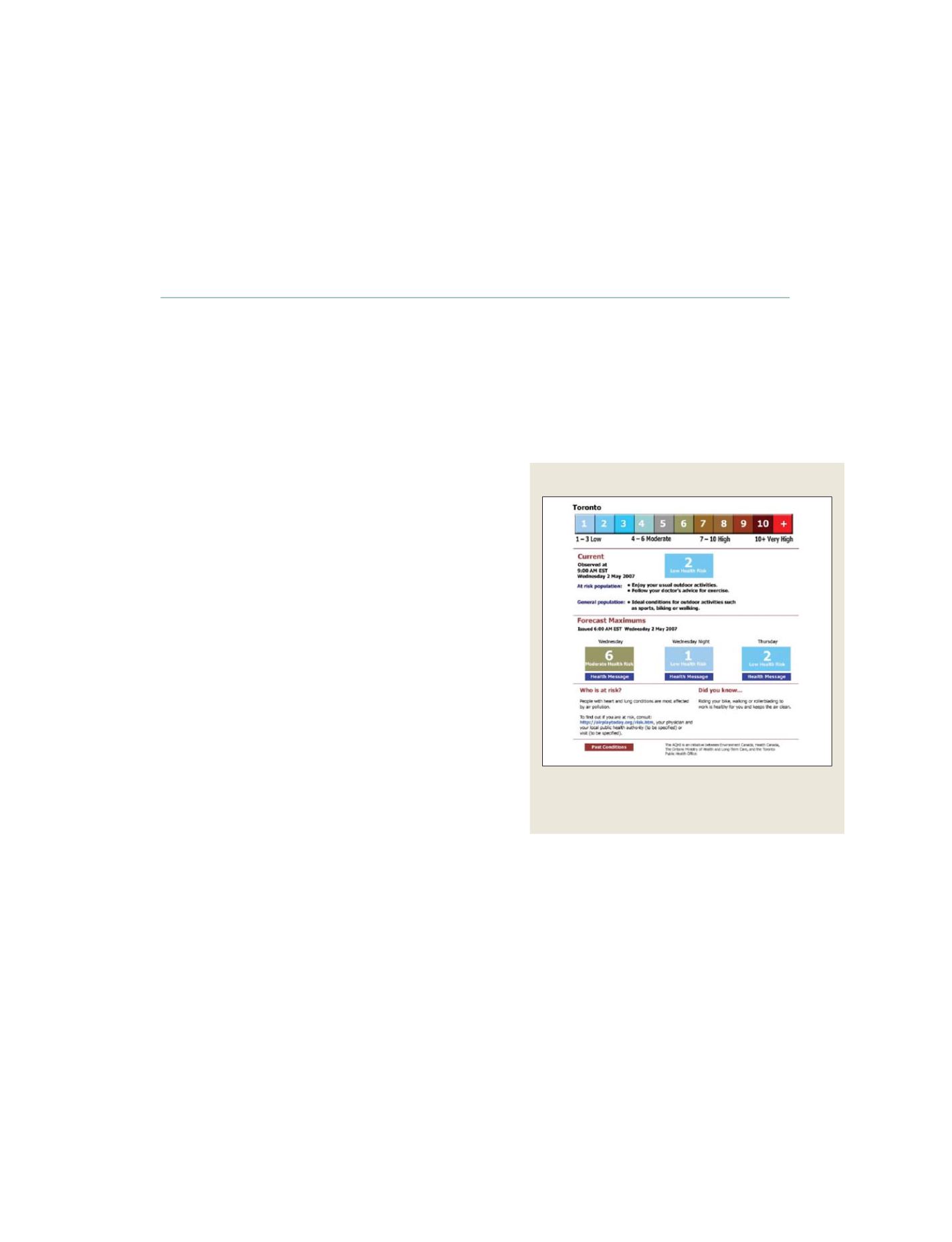

[
] 193
The Air Quality Health Index:
using Canadian Earth observations
for health protection from air pollution
Dave Henderson, Policy Advisor, Air Issues and Sean Daley, Program Officer, Business Policy,
Meteorological Service of Canada, Environment Canada; David M. Stieb, Medical Epidemiologist,
Healthy Environments and Consumer Safety Branch, Health Canada
E
xtensive studies around the world have linked air pollution
to a variety of adverse health effects including premature
mortality, and both respiratory and cardiovascular morbid-
ity. These studies also indicated that certain populations are more
vulnerable to those adverse health effects, namely children, the
elderly, and people with pre-existing cardio-respiratory disease.
Individuals who exercise or do strenuous activities outdoors are
also more susceptible to the negative effects of air pollution.
For nearly three decades Canadians have relied on an Air Quality
Index (AQI) to inform them of measured and forecast air pollution
conditions. It is recognized that these indices are inadequate for
personal health protection because they are:
• Based on thresholds which imply a safe level of single pollutant
concentrations and can not convey that adverse health effects can
be experienced by sensitive members of the population at rela-
tively low pollutant concentrations
• Not designed to reflect a realistic assessment of the mixture of
gases and particles that we breathe
• Inconsistently applied and communicated across Canada, resulting
in the absence of a true national picture of daily air quality, which
limits national media exposure and comparability for travelling.
The move toward an Air Quality Health Index
Health Canada (HC) and Environment Canada (EC) collaborated
with national air quality stakeholders representing health and envi-
ronmental expertise from provinces, municipalities and
non-governmental organizations. Together they developed a national,
health-based approach to presenting air quality information to
Canadians.
Modelled after the successful, Canadian-developed index for ultra-
violet radiation (UV index), the Air Quality Health Index (AQHI)
was designed to provide Canadians with local air quality informa-
tion and forecasts combined with health and environmental
messages, on a daily basis. The AQHI is a personal communications
tool designed to increase public awareness of air quality as a commu-
nity health issue in Canada.
The index follows the principles established by the Group on Earth
Observations (GEO), as it combines observations and information
across sectors to provide a value-added product to society; in this
case information related to human health. The index
will be used to enable Canadians to take appropriate
measures to protect their health in response to changing
air quality conditions and to help motivate them to take
actions to reduce emissions.
The science of the AQHI
As an alternative to linking air quality information to
air pollution standards or guidelines, the AQHI is
founded on the statistical analyses of mortality risks
associated with air pollution for ten large Canadian cites.
Through exhaustive analyses of the 20-year, day-to-day
health impact of air pollution for each location, Health
Canada analysts developed a new health-based formu-
lation derived from mortality statistics. This
The Air Quality Health Index provides Canadians with local air
quality information and forecasts combined with health and
environmental messages
Air Quality Health Index
Source: Environment Canada, 2007
S
OCIETAL
B
ENEFIT
A
REAS
– H
EALTH
















